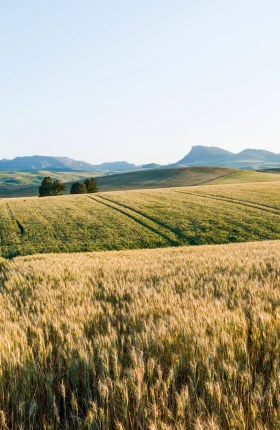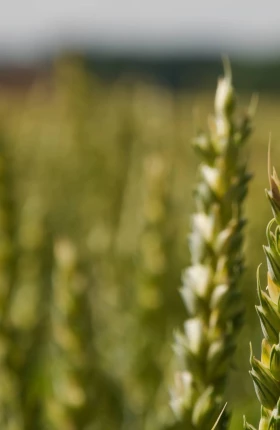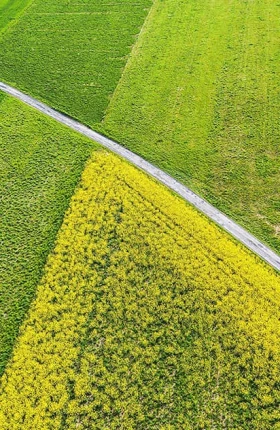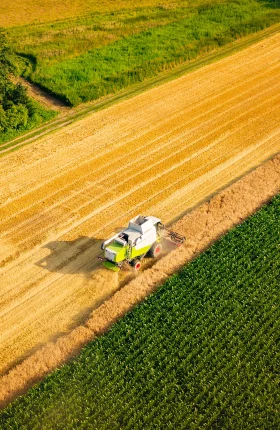Agriculture’s contribution to global warming, and its impact on the environment and biodiversity, are well known. Denmark’s agriculture sector is no exception.
The country’s agricultural activities were responsible for 33% of domestic carbon dioxide equivalent (CO2e) emissions in 2022, making agriculture the sector with the largest share of emissions in Denmark. Farmland covers more than 60% of the country, putting considerable pressure on biodiversity. And the country’s agriculture sector is a major driver of eutrophication—the excess accumulation of nutrients in waters, causing oxygen depletion, often due to leaching and runoff from farmland—along its coasts.
Meanwhile, Denmark’s farmers are under considerable pressure on several fronts. The effects of climate change have led to both droughts and excessive rain, frequently reducing yields. Demand from consumers and large food producers for sustainably grown food is on the rise. Uncertain weather, geopolitical tension, and supply chain disruptions are increasing the volatility of agricultural input costs. And regulators are escalating the pressure to reduce agriculture’s CO2e emissions and impact on biodiversity.
One way to reduce these impacts is by transitioning to regenerative agriculture, a collection of flexible, sustainable farming practices that can improve soil health, lower carbon emissions, increase biodiversity, reduce the need for synthetic fertilizers and crop-protection products, and mitigate the effects of extreme weather events on yields. And the benefits of regenerative agriculture go well beyond the farm and surrounding ecosystems. More resilient yields and reduced carbon emissions will also allow food processors and retailers—and, ultimately, consumers—to reap real economic benefits from the transition.
Yet doubts remain about the economic viability of regenerative agriculture, especially among farmers, who must take on most of the financial risks—including the potential for higher initial costs and lower yields—in the transition from conventional farming practices.
To reduce the economic concerns surrounding regenerative agriculture, BCG, Danmarks Naturfredningsforening, and Food Nation assessed the business case for the practice. (Read the
complete report here
.) Indeed, regenerative agriculture can provide a significant economic benefit to Denmark’s entire agri-food value chain, including farmers, food manufacturers, retailers, and consumers.
The Benefits of Regenerative Agriculture
The key goal of regenerative agriculture is to implement farming practices that are designed to cooperate with nature’s systems, instead of working against them, by focusing on restoring soil health and the surrounding ecosystems. This goal is supported by the three principles at the heart of regenerative agriculture—no-till farming (including direct seeding), permanent coverage of the soil with plants, and more frequent crop rotation.
The benefits of regenerative agriculture are considerable:
- A Smaller CO2e Footprint. Regenerative agriculture requires significantly less use of farming machinery, reducing direct CO2e emissions. Improved soil health increases carbon sequestration, while the declining need for synthetic fertilizers will decrease CO2e emissions from fertilizers that aren’t absorbed into the soil. Our analysis suggests that widespread implementation of regenerative agriculture could have an abatement potential of about 4 megatons of CO2e per year by 2035—roughly 10% of Denmark’s total 2022 emissions.
- Greater Biodiversity. Regenerative agriculture can improve biodiversity both above ground and below it. Reducing the use of synthetic fertilizer—and adopting techniques such as no-till farming, greater coverage of the soil, and more diverse crops—can provide a substantially healthier ecosystem for a wide variety of animals. Less fertilizer and minimal soil disturbance can also help restore the ecosystem of the soil itself, promoting a wide variety of microorganisms.
- Better Water Management. Because regenerative agriculture reduces the need for synthetic fertilizer, it can help lessen the agricultural runoff that causes water pollution and eutrophication in the seas around Denmark’s coasts. And by improving the soil’s ability to absorb and store water, regenerative agriculture reduces the need for irrigation. Thus, it can lower water consumption, offsetting the adverse impacts of droughts. Enhanced water retention also reduces surface water puddling, lowering the risk of crop damage and soil erosion.
Implementing Regenerative Agriculture
The essential regenerative agriculture practices can be implemented in three stages—basic, intermediate, and advanced—over the course of several years. Most stages include three kinds of activities affecting how the soil and crops are cultivated, what inputs are used, and how the land is structured. (See Exhibit 1.)
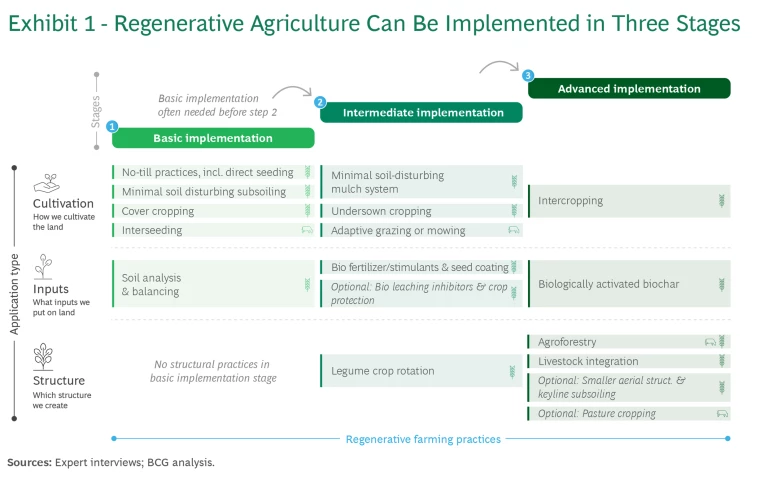
While all of the basic or stage one practices should be carried out as a foundation for the best results, the succeeding stages, and their specific practices, aren’t written in stone. Shifting to regenerative agriculture is a continuous process that requires time to understand each farm’s context. Individual farms will likely require different regenerative practices, subject to what is most effective for their climate and soil type. The key is to reflect, adapt, and regenerate.
The Case for Farmers
We analyzed the impact of the transition to regenerative agriculture on the economics of Danish farms. The results show that, contrary to common perceptions, adopting regenerative agriculture could not only sustain but also significantly enhance farmers’ profitability. Although regenerative farming does incur both initial and ongoing expenses, the medium- to long-term advantages decidedly favor farmers.
The analysis focused on the four main conventional crop types in Denmark: barley, wheat, rapeseed, and corn. Taking a weighted average across these four crop types shows a contribution margin (the profit left over after covering variable costs) of approximately 1,650 Danish kroner (DKK) per hectare, excluding subsidies.
Implementing stage one regenerative agriculture practices would increase the contribution margin by as much as 20% to about 2,010 DKK per hectare. No-till practices could increase it further by an estimated 300 DKK, largely by reducing the cost of tillage and seed preparation. Cover cropping would boost the margin by another 190 DKK by reducing the cost of fertilizer, minus the cost of the seeds for the cover crops. The cost of soil-balancing tests, however, would reduce the overall contribution margin by 130 DKK. (See Exhibit 2.)
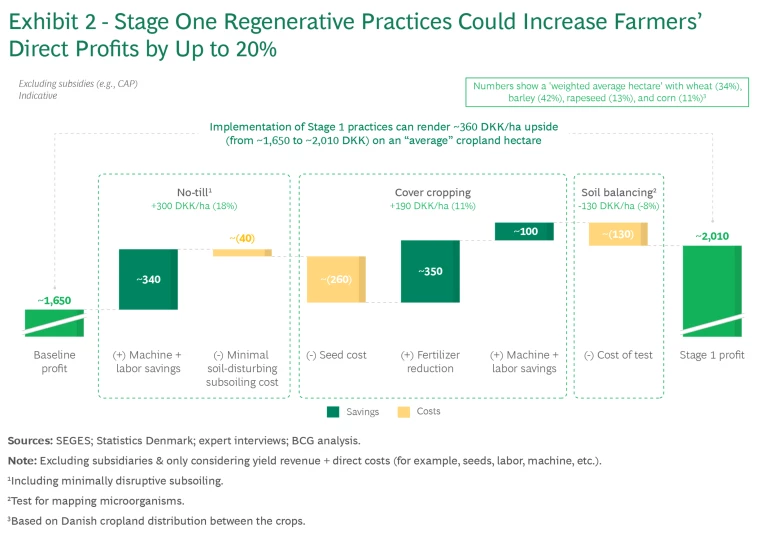
Stage two or intermediate practices, notably mulching and legume crop rotation, would increase the contribution margin by an additional 300 DKK, thanks primarily to lower fertilizer costs. (See Exhibit 3.)
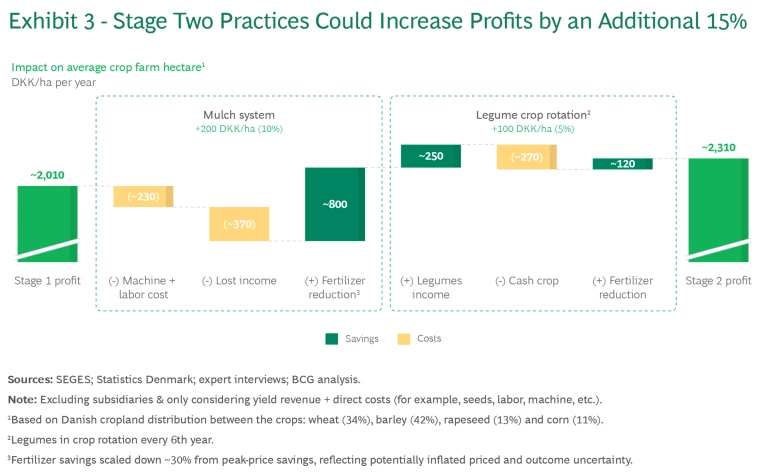
Of course, these estimates can be affected by many factors. When cover crops release nitrogen and how much they release, for example, will depend on the temperatures in the spring and autumn. That, in turn, will affect nitrogen availability for next year’s cash crops and, thus, the actual financial upside. Moreover, the estimates don’t take into account the effect of increased yield resilience or the potential impact of a CO2e tax, currently under discussion in Denmark.
The economic benefits of the advanced stage three practices are harder to quantify. Yet we expect that most farms making the transition will benefit, over time, from improved soil structure, reduced water evaporation and heat, less erosion, and improved leverage of biodiversity and ecosystem services. Some stage three practices may entail additional costs owing to the structural changes needed to implement such practices as agroforestry and intercropping.
The Case for the Danish Agri-Food System
It isn’t just Denmark’s farmers that can profit from the transition to regenerative agriculture; the country’s entire downstream food system—including its food producers, distributors, retailers, and consumers—can also benefit. And because Danish farmers must take on most of the financial risk involved, it is critical that these downstream players support their farmers in the effort.
The key to the business case for downstream players lies in a combination of financial, socio-ecological, and reputational incentives. Moreover, the financial and socio-ecological pressures are closely connected. Consider the impact of extreme weather on food prices. In 2018, for example, crop yields dropped by up to 23%, not only threatening farmer profits but also putting pressure on food companies, which faced increases in rye and barley prices of up to 28% year-over-year for the fourth quarter. The result: profit margins declined for the food-related businesses while prices increased for consumers. Such drops in yields also threaten business-continuity and overall production capacity.
The key to the business case for downstream players lies in a combination of financial, socio-ecological, and reputational incentives.
Over time, conventional agriculture practices, such as monocropping and the use of synthetic fertilizers and crop-protection inputs, can increasingly reduce the health of Denmark’s soil and deplete its nutrients. Under these conditions, yields could gradually decline, and food companies would incur the added cost of finding new sources for their input crops and higher logistics costs as well. The widespread transition to regenerative agriculture could significantly alleviate this risk.
Meanwhile, the Danish government will soon discuss a climate tax on agricultural products. If implemented, the tax could increase the costs for goods with a higher CO2e footprint—costs that would likely be passed on to consumers. Thus, such a tax would likely give a significant boost to crops grown regeneratively, given their lower carbon footprint.
Consumers, too, are becoming increasingly conscious of the need for a more environmentally sustainable agriculture system. While price will always be a key consideration in food purchasing decisions, a tax that reduces the cost of food with a lower carbon footprint could provide an incentive to choose sustainably grown produce. Under these conditions, food companies and retailers could also benefit from gaining a reputation for making and selling more sustainable products, an increasingly important consideration not only for consumers but also for regulators and investors as well.
Lowering Risks, Boosting Returns
As strong as the business case is for regenerative agriculture, a major hurdle to the transition are Denmark’s farmers, who must bear most of the financial risks of the transformation. These include the initial investment for seeds, machinery, and soil testing, as well as the risk that the change in farming practices will lead to a drop in yields in the short to medium term.
The risk for farmers is exacerbated by the fact that Denmark’s agricultural support system (including subsidies, financing, and legislation) primarily is designed for common farming practices, not regenerative agriculture. Greater support would increase farmers’ perceived risk-adjusted return and offer benefits beyond the farm. For example, many Danish farms are heavily mortgaged, so higher potential returns could encourage banks to lend farmers the funds needed to make the regenerative transition.
Lowering the risks for farmers during the transition to regenerative agriculture will require efforts on the part of all players in the Danish food system. Favorable financial products such as green mortgage bonds—increasingly favored by investors looking to invest in instruments with a higher ESG score—can help farmers reduce the interest payments they make on new equipment and inputs.
Lowering the risks for farmers during the transition to regenerative agriculture will require the efforts of all players.
Food producers can play their part by paying a short-term premium for agricultural goods grown regeneratively to help farmers finance their initial investment cost. Long-term purchase agreements with regenerative farmers would ensure a stable market and predictable income for farmers. Food companies could also provide organized advisory support to help farmers gain the knowledge they need to make the transition.
Subsidies could be another way to promote adoption. Farmers in Denmark already rely heavily on subsidies, and Denmark’s strategic plan for the European Union’s Common Agricultural Policy (CAP) already highlights sustainability as a key goal. Incorporating regenerative agriculture practices into local requirements for receiving CAP subsidies can be an effective lever to drive further adoption among current conventional farmers.
The risks for Danish farmers in making the transition to regenerative agriculture are real. However, the greatest risk lies in not making the transition to more sustainable farming practices. The ongoing negative effects of the country’s agriculture sector on its soil, water, biodiversity, and CO2e footprint are unsustainable. The long-term return on investment in regenerative agriculture will be healthier soil, cleaner water, greater biodiversity, significantly lower CO2e emissions—and higher profits for farmers. We encourage the entire Danish agri-food system to support this transition—and especially Denmark’s farmers, whose role as a force for positive change is critical. It will take time, so the time to start is now.






